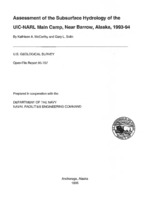Imikpuk Lake serves as the drinking-water source for the Ukpeagvik Inupiat Corporation-National Arctic Research Laboratory (UIC-NARL, formerly known as the Naval Arctic Research Laboratory) near Barrow, Alaska. Previously acceptable hazardous-waste disposal practices and accidental releases of various fuels and solvents during the past several decades have resulted in contamination of soil and ground water in the vicinity of the lake. As part of an assessment of the risk that subsurface contamination poses to the quality of water in the lake, the subsurface hydrology of the UIC-NARL main camp was examined. The study area is located approximately 530 kilometers north of the Arctic Circle, on the northern coast of Alaska, and the short annual thaw season and the presence of shallow, areally continuous permafrost restrict hydrologic processes. A transient ground-water system is present within the active layer-the shallow subsurface layer that thaws each summer and refreezes each winter. Water-level and thaw-depth data collected during the summers of 1993 and 1994 show that the configurations of both the water table and the subsurface frost govern the ground- water flow system in the UIC-NARL main camp and indicate that recharge to and discharge from the system are small. Spatial irregularities in the vertical extent of the active layer result from variations in land-surface elevation, variations in soil type, and the presence of buildings and other structures that either act as a heat source or block heat transfer to and from the subsurface. Distinct features in the active-layer hydrologic system in the UIC-NARL main camp include a permafrost ridge, which generally acts as a flow-system divide between the Arctic Ocean and inland water bodies; a mound in the water table, which indicates increased impedance to ground- water flow toward Imikpuk Lake and acts as a flow-system divide between the lake and Middle Salt Lagoon; and a depression in the water table, which suggests a local breach in the permafrost ridge that allows some ground water to flow directly from the main camp to the Arctic Ocean. Similar thaw depths and water-table elevations were measured during the summers of 1993 and 1994, and little change occurred in the thickness of the ground-water zone between mid- and late-thaw- season measurements. These data suggest that the system is in a state of quasi-equilibrium and that ground-water discharge is small. The observed drop in the water table as the active layer develops over the summer is probably largely the result of evapotranspiration losses rather than system outflow.


